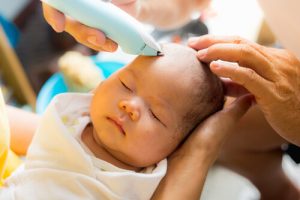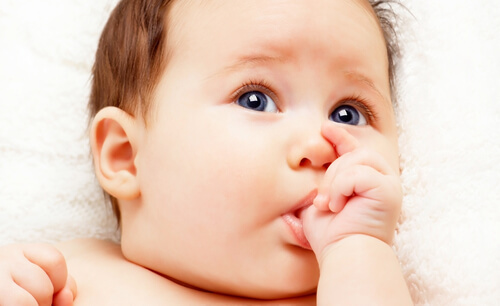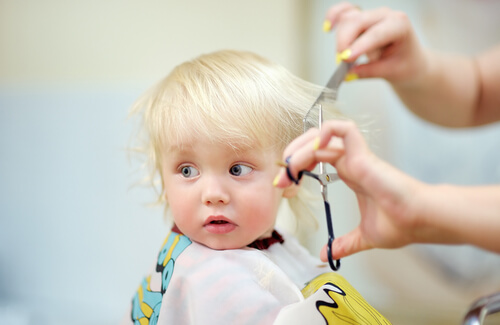Your Baby's First Haircut: Everything You Need to Know

Your baby’s first haircut isn’t a medical procedure, and contrary to popular belief, cutting a child’s hair will not make it grow faster.
It’s up to the parents to decide when to cut their baby’s hair for the first time.
Babies are usually born with a little hair. Some have a full head of hair, while others are born with just a few fine strands.
This difference is genetic. However, having thick hair as a baby is no guarantee against baldness later in life.
Just like their skin and nails, a newborn baby’s hair is delicate. It tends to fall out over the first few days, particularly on the back of the head where the baby rests.
When is the right time for your baby’s first haircut?
There is no right time to cut your baby’s hair. The decision will depend on the parents’ wishes and on common sense.
One important thing to keep in mind is that babies regulate their temperature through their head. After your baby’s first haircut, take special care not to expose them to the cold.
Another important thing to consider is just how many changes babies go through after birth.
Just as soon as they’ve gotten used to living outside of the womb, they’re exposed to hundreds of new stimuli.
For this reason, some specialists recommend waiting one to two months before your baby‘s first haircut.
A good reason to put your baby’s first haircut off for a while is that, from three months of age onwards, children learn to hold their own heads up.
This will make the process a little easier. Even more so at 5 or 6 months of age, when your child is able to sit up on their own.

How to cut your baby’s hair
Some parents prefer to cut their baby’s hair themselves, at home. Others leave it to a specialist at a hair salon that caters for children.
The fact is, if you’re just tidying up a few ends, some blunt-ended scissors and a steady hand are all you need.
Another way to cut your baby’s hair is to use electric clippers. These let you set the length you need.
When using clippers, make sure to take it slow. Avoid putting pressure on your child’s head.
The best time for a baby’s first haircut is when the child is sitting comfortably.
Good moments for a haircut are when your child has just eaten or is happily playing with a toy. You won’t need to wet the hair before you cut it, since the strands are very fine.
“There is no right time to cut your baby’s hair. The decision will depend on the parents’ wishes and common sense”
Recommendations for your baby’s first haircut
- Safety first. Although cutting a baby’s hair isn’t particularly risky, it’s important to take certain precautions. For example, you should hold their head firmly in place to avoid sudden movements. Having another adult nearby may be necessary the first time.
- Make sure to keep the scissors or clippers out of your child’s reach. This is particularly important if he or she is already moving around without your help.
- Wait for the right time. The sound of the clippers or the movement of the scissors can be upsetting for babies. For this reason, it’s far easier to cut your child’s hair when they’re relaxed. If they cry, leave the haircut for another day.
- Put a towel around your child’s shoulders to catch the hair as it falls. You could also give your baby a bath after the haircut. This will help to avoid any discomfort from the loose hair.
- Avoid razors. Razors shouldn’t be used to cut babies’ hair under any circumstance. A razor blade is too harsh on sensitive skin, and you could cut their delicate scalp.

Cradle cap and haircuts
Cradle cap is a crusty layer that can appear on a baby’s scalp during the first few months of life.
Nobody knows what causes cradle cap, but what’s clear is that it’s completely harmless. It can look like dandruff, but is generally yellowish in color.
Although this should not affect your baby’s first haircut, sometimes the layer of cradle cap can get stuck to the skin.
For this reason, it’s a good idea to consult a specialist before attempting to cut your child’s hair.
One way of getting rid of cradle cap is to gently rub their scalp with a soft-bristled brush.
Your baby’s first haircut isn’t a medical procedure, and contrary to popular belief, cutting a child’s hair will not make it grow faster.
It’s up to the parents to decide when to cut their baby’s hair for the first time.
Babies are usually born with a little hair. Some have a full head of hair, while others are born with just a few fine strands.
This difference is genetic. However, having thick hair as a baby is no guarantee against baldness later in life.
Just like their skin and nails, a newborn baby’s hair is delicate. It tends to fall out over the first few days, particularly on the back of the head where the baby rests.
When is the right time for your baby’s first haircut?
There is no right time to cut your baby’s hair. The decision will depend on the parents’ wishes and on common sense.
One important thing to keep in mind is that babies regulate their temperature through their head. After your baby’s first haircut, take special care not to expose them to the cold.
Another important thing to consider is just how many changes babies go through after birth.
Just as soon as they’ve gotten used to living outside of the womb, they’re exposed to hundreds of new stimuli.
For this reason, some specialists recommend waiting one to two months before your baby‘s first haircut.
A good reason to put your baby’s first haircut off for a while is that, from three months of age onwards, children learn to hold their own heads up.
This will make the process a little easier. Even more so at 5 or 6 months of age, when your child is able to sit up on their own.

How to cut your baby’s hair
Some parents prefer to cut their baby’s hair themselves, at home. Others leave it to a specialist at a hair salon that caters for children.
The fact is, if you’re just tidying up a few ends, some blunt-ended scissors and a steady hand are all you need.
Another way to cut your baby’s hair is to use electric clippers. These let you set the length you need.
When using clippers, make sure to take it slow. Avoid putting pressure on your child’s head.
The best time for a baby’s first haircut is when the child is sitting comfortably.
Good moments for a haircut are when your child has just eaten or is happily playing with a toy. You won’t need to wet the hair before you cut it, since the strands are very fine.
“There is no right time to cut your baby’s hair. The decision will depend on the parents’ wishes and common sense”
Recommendations for your baby’s first haircut
- Safety first. Although cutting a baby’s hair isn’t particularly risky, it’s important to take certain precautions. For example, you should hold their head firmly in place to avoid sudden movements. Having another adult nearby may be necessary the first time.
- Make sure to keep the scissors or clippers out of your child’s reach. This is particularly important if he or she is already moving around without your help.
- Wait for the right time. The sound of the clippers or the movement of the scissors can be upsetting for babies. For this reason, it’s far easier to cut your child’s hair when they’re relaxed. If they cry, leave the haircut for another day.
- Put a towel around your child’s shoulders to catch the hair as it falls. You could also give your baby a bath after the haircut. This will help to avoid any discomfort from the loose hair.
- Avoid razors. Razors shouldn’t be used to cut babies’ hair under any circumstance. A razor blade is too harsh on sensitive skin, and you could cut their delicate scalp.

Cradle cap and haircuts
Cradle cap is a crusty layer that can appear on a baby’s scalp during the first few months of life.
Nobody knows what causes cradle cap, but what’s clear is that it’s completely harmless. It can look like dandruff, but is generally yellowish in color.
Although this should not affect your baby’s first haircut, sometimes the layer of cradle cap can get stuck to the skin.
For this reason, it’s a good idea to consult a specialist before attempting to cut your child’s hair.
One way of getting rid of cradle cap is to gently rub their scalp with a soft-bristled brush.
All cited sources were thoroughly reviewed by our team to ensure their quality, reliability, currency, and validity. The bibliography of this article was considered reliable and of academic or scientific accuracy.
- Caring for Your Baby and Young Child. (2016). Caída del cabello (alopecia). HealthyChildren.org. Consultado el 07 de marzo de 2023. https://www.healthychildren.org/Spanish/health-issues/conditions/skin/Paginas/Hair-Loss-Alopecia.aspx
- Johnson & Johnson de Colombia S.A. (2020). El primer corte de pelo de tu bebé. Consultado el 07 de marzo de 2023. https://www.jnjcolombia.com/cuidado-del-bebe/el-primer-corte-de-pelo-de-tu-bebe
- Kenny, P. (2016). Llanto excesivo en los primeros meses de vida: Revisión. Archivos argentinos de pediatría, 114(4), 368-374. Consultado el 07 de marzo de 2023. http://www.scielo.org.ar/pdf/aap/v114n4/v114n4a16.pdf
- Pérez-Machado, J., Rodríguez-Fuentes, G. (2013). Relación entre la postura en prono y la adquisición del sostén cefálico a los 3 meses. Anales de Pediatría, Asociación Español de Pediatría, 79(4), 241-247. Consultado el 07 de marzo de 2023. https://www.analesdepediatria.org/en-relacion-entre-postura-prono-adquisicion-articulo-S1695403313000180
- Romero, R., & Pamela, J. (2021). Conocimiento de las madres primíparas sobre cuidados del recién nacido en el Hospital Ilo –Minsa 2020. Universidad José Carlos Mariátegui. Consultado el 07 de marzo de 2023. http://repositorio.ujcm.edu.pe/handle/20.500.12819/1603
This text is provided for informational purposes only and does not replace consultation with a professional. If in doubt, consult your specialist.








